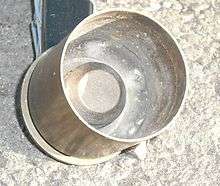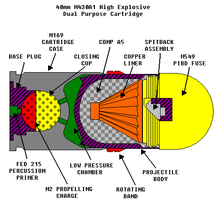40 mm grenade
40 mm grenades[1] are used by grenade launchers in service with many armed forces. There are two main types in service with NATO countries: the 40×46mm,[2] which is a low-velocity round used in hand-held grenade launchers; and the high-velocity 40×53mm, used in mounted and crew-served weapons. The cartridges are not interchangeable. Both 40 mm cartridges use the High-Low Propulsion System.


The less powerful 40×46mm is used in hand-held weapons such as the M79, M203, and the multi-shot M32 MGL. The more powerful 40×53mm is used in automatic grenade launchers mounted on tripods, vehicles or helicopters, such as the Mk 19 grenade launcher. In these roles, the rounds are linked together with a metallic disintegrating-link belt.
40×46mm

- High Explosive (HE): M381, M386, M406, M441
- High Explosive Dual Purpose (HEDP): M433
- Air burst: M397, M397A1
- MP-APERS (Twenty 24-grain metal pellets): M576[3]
- Thermobaric: XM1060
- Star parachute (flare): M583A1
- Star cluster (flare): M585 (white), M661 (green), M662 (red)
- CS gas: M651
- Smoke Canopy: M676 (yellow), M680 (white), M682 (red)
- Ground Marker (smoke): M713 (red), M714 (white), M715 (green), M716 (yellow)
- Practice: M781
- Infra-red illumination: M992
- Less-lethal (crowd control)
- Sponge Grenade (crowd control)
SAGM
The U.S. Army ARDEC began development of a 40 mm airburst fuze in 2011 to improve the ability of grenade launchers like the M203 and M320 to engage targets in defilade. Called Small Arms Grenade Munitions (SAGM), they double the lethality of the standard M433 grenade round by adding a small "smart" fuze sensor that detonates in the air to hit targets in cover or behind obstacles. The airburst function is similar to the XM25 CDTE, which has an onboard laser system to determine the distance to the target, but SAGM is considered complementary to the XM25 rather than competing against it, as the XM25 provides low-angle fire while 40 mm launchers fire a lobbing trajectory. Engineers integrated sensors and logic devices to scan and filter the environment and then autonomously airburst the fuze without needing to be told to by the firer, thereby not requiring the soldier to carry extra weapon accessories. SAGM enables soldiers to accurately incapacitate personnel targets in defilade at ranges between 50 and 500 meters. The round is engineered with three firing modes: airburst; point detonation; and self-destruct. A successful demonstration occurred in November 2013.[4] Although the SAGM sensor does not need a laser rangefinder or any pre-fire programming sequence, it does require some skill by the user to aim and fire the round correctly so that it can detect the wall or obstruction to detonate in the air. The SAGM was to undergo evaluation in July 2015 and, if successful, transition into an official Army program of record by the end of the year.[5] Not only does the fuze burst over walls, but it can detonate when passing cover like trees, bursting just as it senses and passes the trunk. The sort of sensor SAGM uses to differentiate clutter from triggering obstacles is highly classified, but shows airburst reliability of 76 percent.[6]
40×47mm

It is a grenade caliber designed in Poland, and used in Pallad wz. 74 underbarrel grenade launchers (used with AK family rifles in use in Polish Army like the AKM/AKMS, Tantal and Beryl) and Pallad-D wz. 83 Grenade launcher (standalone variant fitted with standard pistol grip and folding stock from AKMS assault rifle). The construction is similar to one used in 40×46mm but grenades are not fully interchangeable.
A caliber with this designation is also used in the Romanian AG-40
40×51mm
Extended Range Low Pressure (ERLP) 40×51mm cartridges extend the range of 40 mm grenades from 400 m to 800 m and are manufactured by companies such as Rheinmetall Denel Munitions.[7]
40×53mm

- High explosive (HE): M383, M384
- High explosive dual purpose (HEDP): M430I
- High velocity canister cartridge (HVCC): M1001[8]
- Practice: M385I, M918
- Dummy: M922/M922A1
- MK285, Programmable Prefragmented High Explosive/Self-Destructible (PPHE/SD) designated specifically for the Mk 47 grenade launcher
The MK285 consists of an electronic programmable fuze, a pre-fragmented warhead and a propulsion system. The fuze is programmed through the fire control of the gun. The fuze is mechanically armed at approximately 23 meters. The round is programmed to airburst over the target and the fuze counts down the programmed time via its built in electronics. If an unprogrammed round is fired, it will detonate on impact. The projectile has a built in self-destruct and can be fired by any automatic grenade launcher.
40×74.5mm
Developed for and used by AGA-40 Md. 85[9]
Other
Other weapons using 40 mm rounds include the Milkor MGL and the Heckler & Koch AG36 and its derivatives. There is also the STK 40 AGL and 40LWAGL from Singapore's ST Kinetics. The Daewoo K4 Grenade Machine Gun is in service with the South Korean Armed Services.
The Soviet GP-25 Kostyor and GP-30 Obuvka and Russian GP-34, BG-15 Mukha and RG-6 use a unique type of 40 mm grenade. These grenades hold their propellant in an expansion chamber at the base of the projectile, functioning more like mortar rounds than conventional cased ammunition. The Soviet 40 mm VOG-25 grenades are not interchangeable with US 40×46mm and 40×53mm weapons.
The Metal Storm Redback 40 mm Weapon System is a four-barrel, 16-round weapon system that uses preloaded barrels containing superposed 40 mm grenades with electrical priming, and is designed for mounting on vehicles.
Green ammunition
The MK281 is a new type of 40 mm target practice grenade ammunition that has been accepted for use into the United States Marine Corps and the United States Army. It is "green" because it is non-toxic and non-dud producing (since it is a training round), meaning that there is no unexploded ordnance left to clean up on the range and heavy metals in the fuze do not leak into the ground. The MK281 was introduced into parts of the U.S. Armed Forces because of an executive order mandating that they buy green ammunition. The MK281 is manufactured by an American subsidiary of the Rheinmetall Group.
The United States Army has a requirement for a non-dud producing 40mm training ammunition in both high and low velocity variants. The Army awarded four contracts to three United States companies to test designs. The resulting ammunition will not contain explosive energetics and have day and night visible, infrared, and thermal signatures.
See also
References
- "Grenade Launchers and their Ammunition: International Developments". Small Arms Defense Journal. Retrieved 24 December 2017.
- "C.I.P. 40 x 46" (PDF). 30 September 2017. Archived (PDF) from the original on 30 September 2017.
- "40mm Low-Velocity Grenades". Inetres.com. Retrieved 24 December 2017.
- Enhanced grenade lethality: On target even when enemy is concealed - Army.mil, 4 September 2014
- ARDEC's airburst round to begin evaluation this summer - Army.mil, 8 December 2014
- New light machine gun: M249 put on weight control - Army.mil, 6 May 2015
- "Rheinmetall Defence - Rheinmetall Denel Munition". Rheinmetall-defence.de. Retrieved 24 December 2017.
- "40mm M1001 HVCC High Velocity Canister Cartridge". Gd-ots.com. Retrieved 24 December 2017.
- "munitie ag 40 Archives - Romania Military". Romania Military. Archived from the original on 21 December 2014. Retrieved 21 October 2014.
External links
- Milkor Worldwide
- 40mm Low-Velocity Grenades
- Defense Review overview of Mk 47 Mod 0 'Striker' 40mm Grenade Machine Gun
- Defense Review overview of Corner Shot 40 personal grenade launcher
- Defense Review overview of Penn Arms PGL65-40 'Fourkiller Tactical Model' 40 mm Multiple Grenade Launcher
- Penn Arms data page for PGL65-40 6-Shot Grenade Launcher
- Defense Review overview of Metal Storm 40mm Weapon System
- Future Weapons: MEI Mercury 40MM Grenade